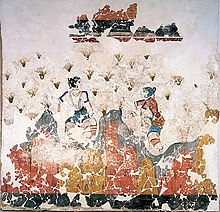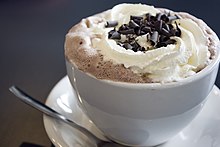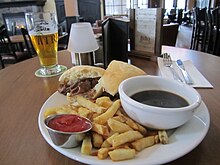Portal:Food
F o o d
A portal dedicated to food and foodways
Introduction


Food is any substance consumed by an organism for nutritional support. Food is usually of plant, animal, or fungal origin and contains essential nutrients such as carbohydrates, fats, proteins, vitamins, or minerals. The substance is ingested by an organism and assimilated by the organism's cells to provide energy, maintain life, or stimulate growth. Different species of animals have different feeding behaviours that satisfy the needs of their metabolisms and have evolved to fill a specific ecological niche within specific geographical contexts.
Omnivorous humans are highly adaptable and have adapted to obtain food in many different ecosystems. Humans generally use cooking to prepare food for consumption. The majority of the food energy required is supplied by the industrial food industry, which produces food through intensive agriculture and distributes it through complex food processing and food distribution systems. This system of conventional agriculture relies heavily on fossil fuels, which means that the food and agricultural systems are one of the major contributors to climate change, accounting for as much as 37% of total greenhouse gas emissions. (Full article...)
Cooking, also known as cookery or professionally as the culinary arts, is the art, science and craft of using heat to make food more palatable, digestible, nutritious, or safe. Cooking techniques and ingredients vary widely, from grilling food over an open fire, to using electric stoves, to baking in various types of ovens, reflecting local conditions. Cooking is an aspect of all human societies and a cultural universal.
Preparing food with heat or fire is an activity unique to humans. Archeological evidence of cooking fires from at least 300,000 years ago exists, but some estimate that humans started cooking up to 2 million years ago.
The expansion of agriculture, commerce, trade, and transportation between civilizations in different regions offered cooks many new ingredients. New inventions and technologies, such as the invention of pottery for holding and boiling of water, expanded cooking techniques. Some modern cooks apply advanced scientific techniques to food preparation to further enhance the flavor of the dish served. (Full article...)
The Modern Cook was the first cookery book by the Anglo-Italian cook Charles Elmé Francatelli (1805–1876). It was first published in 1846. It was popular for half a century in the Victorian era, running through 29 London editions by 1896. It was also published in America.
The book offered elaborate dishes, described with French terminology such as bisque, entrées, entremets, vol-au-vent, timbale and soufflé. It included bills of fare for meals for up to 300 people, and for a series of eight- or nine-course dinners served to Queen Victoria; one exceptional royal dinner in 1841 had sixteen entrées and sixteen entremets, including truffles in Champagne. (Full article...)
Selected article –
Olive oil is a liquid fat obtained by pressing whole olives, the fruit of Olea europaea, a traditional tree crop of the Mediterranean Basin, and extracting the oil.
It is commonly used in cooking for frying foods or as a salad dressing. It can also be found in some cosmetics, pharmaceuticals, soaps, and fuels for traditional oil lamps. It also has additional uses in some religions. The olive is one of three core food plants in Mediterranean cuisine, together with wheat and grapes. Olive trees have been grown around the Mediterranean since the 8th millennium BC. (Full article...)Selected cuisine -

Soul food is the ethnic cuisine of African Americans. It originated in the American South from the cuisines of enslaved Africans trafficked to the North American colonies through the Atlantic slave trade during the Antebellum period and is closely associated (but not to be confused with) with the cuisine of the American South.
The expression "soul food" originated in the mid-1960s, when "soul" was a common word used to describe African-American culture. Soul food uses cooking techniques and ingredients from West African, Central African, Western European, and Indigenous cuisine of the Americas. Soul food came from the blending of what African Americans ate in their native countries in Africa and what was available to them as slaves. The cuisine had its share of negativity initially. Soul food was initially seen as low class food, and Northern African Americans looked down on their Black Southern counterparts who preferred soul food. The term evolved from being the diet of a slave in the South to being a primary pride in the African-American community in the North such as New York City. (Full article...)Selected ingredient –
Whipped cream is heavy, double, or other high-fat dairy cream that is whipped by a whisk or mixer until it is light and fluffy and holds its shape. Cream aerated by the expansion of dissolved gas, forming a firm colloid, is also called whipped cream. It is often sweetened, typically with white sugar, and sometimes flavored with vanilla. Whipped cream is also called Chantilly cream or crème Chantilly (French: [kʁɛm ʃɑ̃tiji]). (Full article...)
Selected recipe –
A French dip sandwich, also known as a beef dip, is a hot sandwich consisting of thinly sliced roast beef (or, sometimes, other meats) on a "French roll" or baguette. It is usually served plain but a popular variation is to top with Swiss cheese, onions, and a dipping container of beef broth produced from the cooking process (termed au jus, "with juice"). Beef stock, a light beef gravy, or beef consommé is sometimes substituted. The sandwich is an American invention, with the name seeming to refer to the style of bread, rather than any French origin. Although the sandwich is most commonly served with a cup of jus or broth on the side of the plate, into which the sandwich is dipped as it is eaten, this is not how the sandwich was served when it was originally developed. (Full article...)

Human cultivation and use of saffron spans more than 3,500 years and extends across cultures, continents, and civilizations. Saffron, a spice derived from the dried stigmas of the saffron crocus (Crocus sativus), has through history remained among the world's most costly substances. With its bitter taste, hay-like fragrance, and slight metallic notes, the apocarotenoid-rich saffron has been used as a seasoning, fragrance, dye, and medicine.
The wild precursor of domesticated saffron crocus was likely Crocus cartwrightianus, a plant native to mainland Greece, Euboea, Crete, Skyros and some islands of the Cyclades. This species has been used as a wild source of saffron. A study reported in 2019 that the authors considered that a cross between two cytotypes of Crocus cartwrightianus was responsible for the emergence of Crocus sativus. This was probably a unique or very rare event as there is no genetic diversity in commercial saffron today. Another study in 2019 showed that a population of Crocus cartwrightianus near Athens in Attica was the closest match to the theoretical ancestors of Crocus sativus. (Full article...)Selected image –

Selected biography –

B. June 25, 1956 – d. June 8, 2018
Anthony Michael Bourdain (/bɔːrˈdeɪn/; June 25, 1956 – June 8, 2018) was an American celebrity chef, author, and travel documentarian. He starred in programs focusing on the exploration of international culture, cuisine, and the human condition.
Bourdain was a 1978 graduate of The Culinary Institute of America and a veteran of many professional kitchens during his career, which included several years spent as an executive chef at Brasserie Les Halles, in Manhattan. He first became known for his bestselling book Kitchen Confidential: Adventures in the Culinary Underbelly (2000). (Full article...)
Did you know (auto-generated) –

- ... that before Angeli Foods was sold this year, the first self-service grocery store in the Upper Peninsula of Michigan had been owned by three generations of a single family?
- ... that by 1967, staff at the Home Office were told not to feed Peta morsels of food as she had become "inordinately fat"?
- ... that food YouTuber Mike Chen also runs a channel documenting strange phenomena?
- ... that Cranksgiving has been described as "part bike ride, part food drive, part scavenger hunt"?
- ... that Phil McGrane used food trucks as his inspiration to increase early voting?
- ... that the vegan-food brand Squeaky Bean produces food that does not contain beans?
More did you know –
Related portals
Food topics
The following are topics relating to food
Categories
Food list articles
- See also: Lists of foods and Category:Lists of drinks
The following are some Food list articles on Wikipedia:

- American cheeses
- Appellation d'Origine Contrôlée cheeses
- Apple cultivars
- Bacon dishes
- Bacon substitutes
- Basil cultivars
- Breads
- Breakfast beverages
- Breakfast cereals
- Breakfast foods
- British cheeses
- Cakes
- Candies
- Cheeses
- Cheese soups
- Christmas dishes (list)
- Cocktails
- Cookies
- Dishes using coconut milk
- Diets
- Doughnut varieties
- Egg dishes
- Fermented soy products
- Food additives
- Food additives (Codex Alimentarius)
- Foods named after people
- French cheeses
- French dishes
- Fried dough foods
- Fruits
- List of hamburgers
- Herbs and spices
- Hors d'oeuvre
- Indian dishes
- Indian snack foods
- Indonesian dishes
- Italian dishes
- Japanese snacks
- Japanese dishes
- Jewish dishes
- Kebabs
- Korean beverages
- Mango cultivars
- Moroccan dishes
- Pasta
- Pastries
- Philippine snack food
- Pies, tarts and flans
- Poppy seed pastries and dishes
- Potato dishes
- Puddings
- Raw fish dishes
- Rice dishes
- Rolled foods
- Sauces
- Seafood
- Seeds
- Sandwiches
- Snack foods
- Soft drinks by country
- Soul foods and dishes
- Soups
- Stews
- Street foods
- Tapas
- Turkish dishes
- Twice-baked foods
- Vegetable oils
- Vegetables
- Vodkas
Things you can do
Related WikiProjects
| Parent project: WikiProject Food and Drink | |
| Child projects: | Task forces: (All inactive) |
|
|
| Related projects: | |
New articles
Rules | Match log | Results page (for watching) | Last updated: 2024-05-31 19:27 (UTC)
Note: The list display can now be customized by each user. See List display personalization for details.
- Brennans Bread (edit | talk | history | links | watch | logs | tools) by Gatepainter (talk · contribs · new pages (3)) started on 2024-05-31, score: 20
- Karin-Lis Svarre (edit | talk | history | links | watch | logs | tools) by Ipigott (talk · contribs · new pages (13)) started on 2024-05-31, score: 10
- Indori poha (edit | talk | history | links | watch | logs | tools) by Apocheir (talk · contribs · new pages (5)) started on 2024-05-30, score: 20
- Tanuki (restaurant) (edit | talk | history | links | watch | logs | tools) by Another Believer (talk · contribs · new pages (111)) started on 2024-05-30, score: 10
- Lena Ice Cream (edit | talk | history | links | watch | logs | tools) by Syazwi Irfan (talk · contribs · new pages (4)) started on 2024-05-23, score: 30
- Ko Myeong-seok (edit | talk | history | links | watch | logs | tools) by Explicit (talk · contribs · new pages (4)) started on 2024-05-30, score: 10
- Savanyúság (edit | talk | history | links | watch | logs | tools) by Konnor Martin (talk · contribs · new pages (1)) started on 2024-05-29, score: 10
- Laal maas (edit | talk | history | links | watch | logs | tools) by SafariScribe (talk · contribs · new pages (157)) started on 2024-05-29, score: 30
- Furrundu (edit | talk | history | links | watch | logs | tools) by BaduFerreira (talk · contribs · new pages (3)) started on 2024-05-29, score: 50
- Hyman's Seafood (edit | talk | history | links | watch | logs | tools) by DMVHistorian (talk · contribs · new pages (6)) started on 2024-05-28, score: 10
- Pickup Coffee (edit | talk | history | links | watch | logs | tools) by Hariboneagle927 (talk · contribs · new pages (20)) started on 2024-05-28, score: 20
- Geoffrey Hawtin (edit | talk | history | links | watch | logs | tools) by Chromista (talk · contribs · new pages (1)) started on 2024-05-28, score: 10
- Palani Panchamirtham (edit | talk | history | links | watch | logs | tools) by Magentic Manifestations (talk · contribs · new pages (13)) started on 2024-05-27, score: 10
- Erismatopterus (edit | talk | history | links | watch | logs | tools) by Kevmin (talk · contribs · new pages (20)) started on 2024-05-27, score: 10
- Saskatoon berry pie (edit | talk | history | links | watch | logs | tools) by Reywas92 (talk · contribs · new pages (2)) started on 2024-05-27, score: 30
- Zus Coffee (edit | talk | history | links | watch | logs | tools) by Hariboneagle927 (talk · contribs · new pages (20)) started on 2024-05-27, score: 20
- Space Cola Wars (edit | talk | history | links | watch | logs | tools) by Artem.G (talk · contribs · new pages (13)) started on 2024-05-27, score: 10
- Conchas de Piedra (edit | talk | history | links | watch | logs | tools) by Another Believer (talk · contribs · new pages (111)) started on 2024-05-27, score: 10
- Torta Balcarce (edit | talk | history | links | watch | logs | tools) by Murmuring Rock (talk · contribs · new pages (4)) started on 2024-05-25, score: 20
- Bilal Yalcinkaya (edit | talk | history | links | watch | logs | tools) by Das osmnezz (talk · contribs · new pages (55)) started on 2024-05-23, score: 10
- Andok's (edit | talk | history | links | watch | logs | tools) by Karich28 (talk · contribs · new pages (4)) started on 2024-05-22, score: 20
- Doe Donuts (edit | talk | history | links | watch | logs | tools) by Another Believer (talk · contribs · new pages (111)) started on 2024-05-23, score: 10
- I, the Executioner (2024 film) (edit | talk | history | links | watch | logs | tools) by Οἶδα (talk · contribs · new pages (55)) started on 2024-05-21, score: 10
- Virginia Sole-Smith (edit | talk | history | links | watch | logs | tools) by Marquardtika (talk · contribs · new pages (1)) started on 2024-05-22, score: 10
- Lohusa şerbeti (edit | talk | history | links | watch | logs | tools) by Macrakis (talk · contribs · new pages (8)) started on 2024-05-22, score: 30
- I, the Executioner (edit | talk | history | links | watch | logs | tools) by Οἶδα (talk · contribs · new pages (55)) started on 2024-05-21, score: 10
- Paul Parkman (edit | talk | history | links | watch | logs | tools) by Thriley (talk · contribs · new pages (67)) started on 2024-05-21, score: 10
- Two Roosters Ice Cream (edit | talk | history | links | watch | logs | tools) by Johnson524 (talk · contribs · new pages (4)) started on 2024-05-21, score: 10
- There Be Monsters (edit | talk | history | links | watch | logs | tools) by Another Believer (talk · contribs · new pages (111)) started on 2024-05-21, score: 10
- Chinir saaj (edit | talk | history | links | watch | logs | tools) by Moriwen (talk · contribs · new pages (264)) started on 2024-05-21, score: 30
- Doogh (edit | talk | history | links | watch | logs | tools) by MuhammedBenShalom (talk · contribs · new pages (1)) started on 2024-05-21, score: 20
- Sata physic gardens (edit | talk | history | links | watch | logs | tools) by MChew (talk · contribs · new pages (17)) started on 2024-05-21, score: 10
- Nam Dae-sik (edit | talk | history | links | watch | logs | tools) by Das osmnezz (talk · contribs · new pages (55)) started on 2024-05-20, score: 10
- Le Chique (edit | talk | history | links | watch | logs | tools) by Another Believer (talk · contribs · new pages (111)) started on 2024-05-20, score: 10
- Khanom met khanun (edit | talk | history | links | watch | logs | tools) by Quantplinus (talk · contribs · new pages (1)) started on 2024-05-18, score: 10
- Pao Alentejano (edit | talk | history | links | watch | logs | tools) by Valereee (talk · contribs · new pages (9)) started on 2024-05-20, score: 10
- Sir Grapefellow and Baron von Redberry (edit | talk | history | links | watch | logs | tools) by Retrosunshine2006 (talk · contribs · new pages (1)) started on 2024-05-20, score: 20
- Pharasmanes II (edit | talk | history | links | watch | logs | tools) by BilledMammal (talk · contribs · new pages (199)) started on 2024-05-19, score: 10
- Kinamatisang manok (edit | talk | history | links | watch | logs | tools) by Obsidian Soul (talk · contribs · new pages (7)) started on 2024-05-19, score: 10
- Federal Food, Drug, and Cosmetic Act of 1938 (edit | talk | history | links | watch | logs | tools) by Irruptive Creditor (talk · contribs · new pages (2)) started on 2024-05-19, score: 10
- IT'SUGAR (edit | talk | history | links | watch | logs | tools) by AbsentPat (talk · contribs · new pages (3)) started on 2024-05-19, score: 20
- Harvey's Butter Rum Batter (edit | talk | history | links | watch | logs | tools) by AbsentPat (talk · contribs · new pages (3)) started on 2024-05-19, score: 20
- Mar-Jac Poultry (edit | talk | history | links | watch | logs | tools) by TJMSmith (talk · contribs · new pages (13)) started on 2024-05-18, score: 10
- Festival del Sole (edit | talk | history | links | watch | logs | tools) by 87.74.175.29 (talk · contribs · new pages (2)) started on 2024-05-18, score: 20
- Joyride Sweets (edit | talk | history | links | watch | logs | tools) by Bennett1203 (talk · contribs · new pages (23)) started on 2024-05-18, score: 40
- Khanom Med Khanoon (edit | talk | history | links | watch | logs | tools) by Quantplinus (talk · contribs · new pages (1)) started on 2024-05-18, score: 10
- Tony Connor (musician) (edit | talk | history | links | watch | logs | tools) by Anavatar (talk · contribs · new pages (8)) started on 2024-05-18, score: 10
- Patrick Olive (edit | talk | history | links | watch | logs | tools) by Anavatar (talk · contribs · new pages (8)) started on 2024-05-18, score: 10
- Taquería El Califa de León (edit | talk | history | links | watch | logs | tools) by Tbhotch (talk · contribs · new pages (28)) started on 2024-05-18, score: 10
- Harvey Hinsley (edit | talk | history | links | watch | logs | tools) by Anavatar (talk · contribs · new pages (8)) started on 2024-05-17, score: 10
- Fulcrum Coffee (edit | talk | history | links | watch | logs | tools) by Another Believer (talk · contribs · new pages (111)) started on 2024-05-17, score: 10
Associated Wikimedia
The following Wikimedia Foundation sister projects provide more on this subject:
-
Commons
Free media repository -
Wikibooks
Free textbooks and manuals -
Wikidata
Free knowledge base -
Wikinews
Free-content news -
Wikiquote
Collection of quotations -
Wikisource
Free-content library -
Wikiversity
Free learning tools -
Wiktionary
Dictionary and thesaurus















































